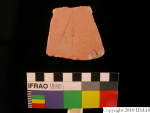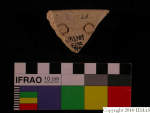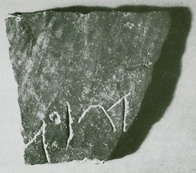Criteria–1: decorative vs. informational
How may we distinguish between decorative and functional or informational uses of incised patterns on ceramics? It seems safe to assume that regular repetition of the same motif is decorative – thus, for example, with the oblique lines on a raised band that imitates a rope along the shoulder of a vessel. A choice is less certain when dealing with unique motifs, whether a representational figure or a geometrical pattern: is this the reflection of a decorative whim or a symbol that is meant to convey information?
We can use the following criteria as a guide.
|
type |
decorative |
informational |
|
| 1 |
impact of tool |
displaces surface |
removes surface |
We can tell whether the surface is dry or wet depending on whether or not there is a ridge along both sides of the incision: lack of a ridge indicates that the tool scraped a hard surface. Such scraping is disassociated from the time of manufacturing of the ceramic object, hence related to the intent of conveying information not tied to the nature of the object itself. |
| 2 |
use of tool |
edge |
point |
If the tool is placed along its edge, the line is more likely to be straight than if the pointed tip of the tool is used to draw a line. Placing along the edge can only be done on wet clay, hence the same remarks obtain as for N. 1 above. |
| 3 |
object |
whole vessel |
ostracon |
If the sign was originally scratched on a sherd, rather than impressed on a whole ceramic object, it is divorced from any referentiality to such object. This is what is normally understood as an ostracon. And signs on an ostracon are unlikely to be purely decorative. A sign scratched on a hard ceramic surface is more likely to imply the presence of an ostracon, but not necessarily so. One may also assume that an alignment of a sign along the wheel marks may be originally linked to a whole vessel. |
| 4 |
morphology of sign |
random |
repetitive |
If a sign, however simple, has a defined morphological definition that is repeated on different objects, it is more likely to be associated with an informational purpose. |
| 5 |
syntax of signs |
aesthetic effect |
sequentiality |
If morphologically distinctive signs occur in repetitive syntactical sequences that have no apparent aesthetic purpose, they are highly likely to be informational in nature. |
| 6 |
historical dimension |
isolated |
link to complex systems |
If both morphology and syntax can be shown to match the distributional patterns found in later systems, especially later alphabets, it is very likely that they may be considered as historical antecedents of the same. |
Back to top
Criteria – 2: support referential and not
Once we can assume that a sign has an informational function, we must define its referential range. If a sign refers specifically to the object with which it is associated, e.g., a ceramic vessel, then it is less likely to be part of a writing system. Such a system is in fact wholly non-referential to the medium that supports it, it has a validity of its own that transcends the link to the object, the vessel, or, of course, the ostracon or the tablet.
Referentiality to their support is apparent, for example, in potter's marks that refer to the maker, the user or the content of a given vessel, which are strictly associated with the vessel on which they are found.
It is of course quite possible for both aspects to coincide, i.e., for a "text," which in and of itself is non-referential, to be written on an object to which it actually refers. But then the intrinsic non-referentiality of the text has already been established on other grounds.
Back to top
Incised sherds from Urkesh
There are, as of this writing, two sherds from the excavations in the Temple Plaza that are incised with what may be an alphabetic character The first one, J1q1211.1, is from the topsoil, and thus cannot be dated stratigraphically. The second, J5q389.1, can be dated stratigraphically to the ED III period.
The arguments in support of an alphabetic interpretation are given under each entry, the main one being the close formal correlation to practically identical signs found in a context (given in the J1q1211.1 entry) where the alphabetic interpretation seems certain. This context (Kumidi) dates to the Late Bronze age, and is thus pertinent to the J1 example.
The J5 example, on the other hand, is dated to the ED III period, and the iterpretation of the sign as an alphabetic character seems thus more difficult. We may however refer to two incised sherds from Tell Chuera.
|
|

J1q1211.1

J5q389.1
|
Back to top
Incised sherds from Tell Chuera.
Sherd N.1 was published in the 1976 report of the 1974 season, pp. 30-33. The signs were incised after the firing of the vessel. Even though the sherd was first seen in the sherdyard (p.30), the excavators feel confident that it comes from rooms 61-62 of the small Anten-Tempel, because it belongs to the same typology as that of the other sherds that were next to it.
The commentary by Ali Abu Assaf and Wolfgang Röllig agrees in recognizing a possible line written in alphabetic characters, which may read from right to left as GP / ‛G. The paleography places the writing in the early first millennium: the second millennium being very unlikely, and the third impossible.
Sherd N.2 was published in the 1978 report of the 1976 season, pp. 38-39. The two signs were incised before firing. The sherd was found in the west extension of the excavations of the small Anten-Tempel, at the level of the courtyard. Hence in this case an ED III date is certain.
Wolfgang Röllig reads the signs very tentatively as x PN x.
|
|

1

2
|
Back to top
Incised sherds from Kamid el-Loz.
Six sherds from Kamid el-Loz are incised with a sign that is very close in shape to the one on the J1 sherd. They are reproduced below from the drawings in the original publication (pp. 27-28, see also pp. 24-25), the numbers referring to the number of the "ostracon" as given ibidem. Mansfeld stresses the fact that the Late Bronze ostraca from Kamid el-Loz are the earliest known evidence of an alphabetic script, ostraca 1 and 2 from the citadel being slightly older than 3-8 from the temple (stratum 3b), antedating the alphabetic cuneiform of Ugarit (p. 38). He also points to the fact that the Aleph sign is surprisingly well developed (p. 39). Mansfeld reads the parallel lines incised next to the characters as numeric notation (p. 31).
|
|

1

2
|
Back to top
Questions of temporal and spatial distribution
On p. 39 of the 1978 report of the 1976 season, Moortgat and Moortgat-Correns write that the existence of a Semitic alphabet writing already in the third millennium during the Mesilim period can no longer be doubted. But there are serious problems with this conclusion. Proper alphabetic writing can be assumed only for the first sherd, where more signs, and with more distinctive shapes, are present. And the provenance (hence the date) of this sherd cannot be said to be beyond doubt.
On the other hand, the Late Bronze age signs from Kamid el-Loz (cited in conjunction with the Urkesh sherd can be convincingly explained as evidence for alphabetic writing. It seems therefore not impossible that both the first Chuera sherd and the Urkesh sherd J1q1211.1 might belong to the same tradition: a Late Bronze age alphabetic writing that, at home in the west (Kumidi) spreads through the Mittani territories to the east (Chuera=Harbe and Mozan=Urkesh). Since both the Chuera and the Mozan sherd may be considered to be, in different ways, surface finds, they may well belong to the latest period of occupation of the site, hence the Late Bronze age to which the Kamid el-Loz sherds belong.
Back to top
|
| |



